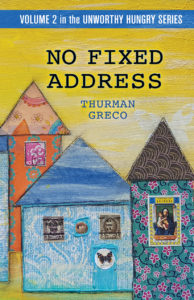Reality in the Food Pantry
“How did we all fit?” What is the reality in the food pantry?
New shoppers always had funny looks on their faces the first time they shopped at the pantry. They expected to fill out forms. They expected to prove through documents they existed, had an address, and deserved the food.
They brought social security cards, utility bills, pay stubs, birth certificates. They came prepared to surrender their innermost private lives in exchange for recycled food originally rejected by a farmer, food manufacturer, grocer, wholesaler. It was all bound for a landfill.
The pantry didn’t have much in the way of screening procedures. For intake, shoppers signed their names and wrote the number of seniors, adults, and children in the household.
Nobody showed documents, especially not their social security cards. Our forms didn’t ask for addresses because the first inspector to visit the pantry after I became the coordinator assured me they weren’t necessary.
On pantry day, hungry people lined up and went through the pantry as fast as we could process them. In the two-to-three minutes they had in the room, they took their share of everything on the shelves, regardless of what it was. I never saw a person turn up a nose at canned peas, fresh spaghetti squash, or beets.
Pantry food is a shock to hungry people on their first visit. They see unrecognizable items. They sometimes sought a realitycheck. They don’t know what they’re called, how to prepare and eat them, how to store them. They have no idea what the nutritional content is.
Often, ethnic shoppers have no money and are separated from anything and everything they know or experienced. Undocumented citizens have no money, know few or no people, probably can’t speak the language, and they are forced by circumstances to shop in a pantry offering nothing familiar to eat. This must be a lonely feeling. They questioned the reality of their circumstance.
Worse, finding ethnic food, kosher food, Asian food, is simply not going to happen in a pantry. This is not necessarily by design. Food pantries only have food available to them that the food bank has to share. And, of course, the food bank shares what is donated.
At the end of the shift on pantry day, in the quiet of the closed pantry room, I counted totals. I carefully added the children, adults, seniors, and households in the pantry line that day. Often I was surprised at the end of a shift that such large numbers of hungry people shopped in the pantry in one afternoon.
The State of New York sent down clear guidelines, rules, conditions about what, how, and when pantries distributed food donated to hungry people.
Produce came from area farms. The Hepworth Farm, the Patroon Farm (owned by the Food Bank of Northeastern New York), and Migliorelli Farm as well as from other area farms throughout the Hudson River Valley, throughout the nation, and from foreign countries even. Farms grew and gave beautiful, fresh, clean, colorful, aromatic produce.
Produce made its way from a farm to a wholesaler, food manufacturer, and finally, a bakery or grocery chain in New York State. Food manufacturers, wholesalers, farmers, supermarkets salvaged food and donated it to the food bank. And that’s where the food banks came in. Food pantries received rejected food anywhere along the food chain. Volunteers put it on the shelves, and distributed it to hungry people lacking money to buy food.
Most fresh produce came directly to the food bank and what received was often organic but not labeled. It costs money to label produce as organic. The stickers alone cost money. Paying someone to apply them is another cost. The reason against labeling the produce is practical. Labeled or not, this beautiful food kept shoppers from feeling they were getting rations. That’s how the State of New York wanted it.
Not all Hudson Valley farms used organic methods. Migliorelli Farms, for example, didn’t label produce as organic because this family-owned farm used European agricultural standards to reduce health risks and exposure to pesticides by incorporating crop rotation, fertilization, irrigation, and planting systems.
Never ours, the food was in our safekeeping to give to hungry people, homeless people, the mentally ill, physically ill, poor, to anyone in need. Leastways, that was what I thought we were supposed to do with it.
New York State tax dollars worked in the pantry. When volunteers worked at the pantry, we did so willingly and for free.
Sometimes I thought I was the only one in town to see it this way. Many felt I fed the unworthy hungry, that I embraced the wrong people. None of the food boxes came to the pantry stamped Worthy Hungry Only. I never understood what unworthy hungry meant, who the unworthy were, where they came from. I didn’t understand unworthy hungry the same way I didn’t understand rocket science. I just didn’t get it. Because I didn’t get it, no one could sway my beliefs.
Instead, I understood hunger, giving, receiving, sharing, and abundance. When people signed their names and accepted food, miracles rippled out beyond the building, beyond walls and boundaries – to a divine experience.
While shoppers got food, they sought the resources to live meaningful lives and to trust there was something to believe in, cling to. They sought the focus to rebuild lives.
At the pantry day’s end, I was thankful people got groceries.
I searched and searched and got beyond hunger and abundance. My search was about the meaning of life. In my youth, (in my thirties), I asked two questions: What is the meaning of life? Whatever happened to the Anasazi?
In the pantry (in my seventies), I still searched for the meaning of life. My questions were different: How did I end up in a food pantry at my age? Who are the unworthy hungry. My questions were wrong. What I should have asked was “why”, now “how” or “who”.
All my life I felt when I got to be a woman of a certain age I would sit in the rocking chair I inherited from my grandmother and learn to knit or crochet. Maybe I would occasionally venture beyond home in my yellow Volkswagen convertible with a black top to paint a picture or two in a class nearby. I fantasize the top would be down at every outing to free my cotton top curls.
Instead, I worked in a small town food pantry in the midst of the biggest economic downturn for decades.
I managed a food pantry in a community where some weren’t interested in recognizing poverty and hunger existing under their very noses.
It came down to reality. I never found discovered the unworthy hungry because I never saw anyone in the pantry who didn’t need food. Those preoccupied with feeding with the unworthy hungry saw freeloaders who didn’t need the food, or didn’t belong in the line.
I saw grandmothers and mothers with children standing in the line without uttering a sound. Not in my wildest dreams did I figure out how they got the children to be so quiet and stand so still. Grandparents, aunts, uncles, siblings, and close friends stood in the line for as much as an hour on Wednesday or Thursday afternoon with children, mostly preschoolers.
Caregivers stood in the hallway weekly in cold, wet, dry, rain, snow, broiling heat inching their way down the long hall until their turn came in the pantry room. No one, either child or adult, complained about the freezing cold hallway in the winter where the only warmth came from the body heat of fellow shoppers. The nearest I ever got to a complaint was volunteers and shoppers wearing two hats in the winter. No one, neither adult nor child, complained about the oppressive summer hallway heat. The children never made a peep.
Many lived on fixed incomes unprepared for the financial costs and emotional roller coaster ride involved in raising someone else’s children. Ready or not, they cared for children when the biological parents couldn’t. For some, the situation was overwhelming. For others, it was just another day.
THREE SHOPPERS
I saw a cancer patient with finances reduced to a large box filled with bills and no money in the bank. He shopped weekly until his death.
I saw the woman whose brother had Alzheimer’s. She was his caregiver and he couldn’t be left alone. Sometimes she arrived at the pantry so disheveled it was difficult for her to stand in the line and shop. One afternoon she crashed her car into the bridge outside the pantry entrance.
I saw the widow with more month than money who refused to go to her children for help. She visited the pantry regularly. One shopping trip included the first anniversary of her husband’s death. She kept her pantry trips a secret from her children because she was embarrassed to let them know. This was a small community, so they eventually figured things out.
THE MOTHER AND GRANDMOTHER
She brings her young granddaughter to the pantry weekly. Sue is maybe four. She is shy. Dark brown ringlets frame her little cherubic face. Her expressions and posture tell me she’s still unaware of her situation. Her mother works two plus jobs. There’s not enough food to eat in this household. Her little dresses are threadbare.
This lovely child takes pleasure in the smallest gifts. Today, her treat is a can of juice a volunteer found in the storeroom that’s not dented. Her grandmother teaches her to stand in line quietly, smile, and say “thank you.”
When I see them, I see the universal mother and grandmother next door. I see a mother and grandmother working hard so that adorable little child has access to a good school, health care, safe streets.
They are our neighbors.
They are our family.
They are us.
I’m reminded we do not live in a we/they world.
Poverty hits children especially hard, with long-term consequences for behavior, learning, and mental health. They suffer the effects of going to bed hungry. Ketchup sandwiches and bowls of dry cereal don’t offer the nutritional strength a child needs to grow up into a healthy adult.
However this shakes out, the hungry are us.
Thank you for reading this post. Please refer it to your preferred social media network.
Thurman Greco

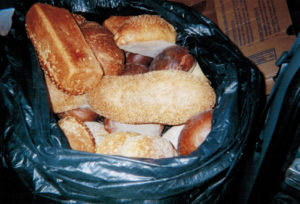
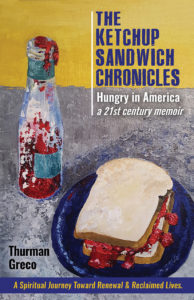
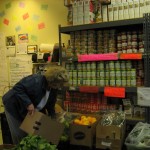
New Beginnings – Part 2 as I Explore the Spirituality of Hunger in America
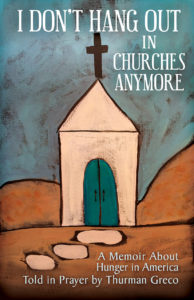
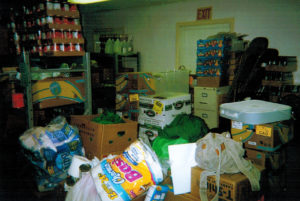
Like many first-time pantry volunteers everywhere, I showed up that morning because someone from the church asked me to come. A slot needed to be filled and I stepped up to the plate when I was asked. I was a foot soldier in the army of the outreach. I tried to live up to my status in the church as a new member. I showed up at whatever activity needed help and did my share. Nothing more.
I had no desire to move up any ladder in the congregation.
On that morning of new beginnings, I had no premonition I would ever return to this pantry room.
I had no plans for this place in my future. I had a profession teaching reflexology, Reiki, and canine massage therapy in a healing space in my home on Tannery Brook.
This was a case of fools rushing. Knowing what I know now, I should have run out the door and never looked back. Mary could have handled the crowd that day without me. In the whole two hours, no more than a couple dozen people visited the pantry.
I wasn’t blessed with any psychic knowledge…certainly not the feeling of danger I felt when I saw the head of the building committee in the hallway outside the pantry months later.
There were no lines in the hallway at the new beginnings of my time there. People wandered into the pantry in groups of one and two to choose from cereal, soup, tuna, and peanut butter.
Never in my wildest thoughts on that day did I envision the pantry hallway filled with hungry people, the tiny room packed with fresh produce and jammed with shoppers.
By 2008, the tanked economy was well underway and waits in the hallway were an hour or more.
The Hunger Prevention Nutrition Assistance Program (HPNAP) passed down feeding guidelines which included whole-grain bread, 1% milk, fresh produce. By 2011, the building committee had rules dictating where people could stand, what bathroom they could use, and what parts of the hallway were off-bounds.
Never did I foresee monthly food deliveries averaging over 12,000 pounds.
Never did I imagine, on that day, building committee members angry over hungry people receiving food according to guidelines set down by the State of New York, the Department of Health, and the United States Department of Agriculture.
I never thought I would spend months grappling with the unworthy hungry, a concept introduced to me by a local religious leader. The concept wasn’t explained. Only the two words – unworthy hungry – were used in a sentence: “You are feeding the unworthy hungry.” This was something I never heard of before. What did she mean? Who were the unworthy hungry?
After that first morning in the food pantry, I drove home, pulled out a little notebook from a drawer and wrote what people said, like real writers do. When I wrote these things down, I felt my grandmother’s presence.
Her spirit was with me in the room. I looked around the dining area to see if someone had entered the room without my realizing it. But, no, I didn’t find a soul. I walked over to a cabinet and began my dialogue journal on that afternoon.
A shopper: “They cut my food stamps again. I don’t know how I’m going to make it. I have no money this month. My car died and I don’t know where I’m going to get money to fix it. If I can’t fix it, I can’t buy a new one either.”
Lillie Dale Cox Thurman spoke to me clearly that morning with emphatic, strong, direct instructions. She went straight to my head: “Write this down! Write this down too! Now…write this down.”
My grandmother, Lillie Dale Cox Thurman, stepped into my life on the first morning in the food pantry and never left. Not even when my mother, Uralee Thurman Lawrence, roared in with prayers and fast, furious, aggressive instructions which I resisted to the bitter end. Under their directions, I joined the crowd in the basement and was soon volunteering regularly.
So, now, I’ve got the second volume, “The Ketchup Sandwich Chronicles,” coming out on this blog.
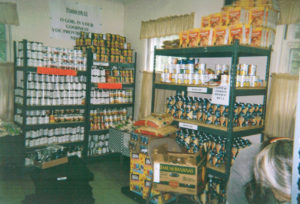
Thank you for reading this blogged book! Please refer it to your preferred social media network and stay tuned for future chapters!
Thurman Greco

Exploring the Spirituality of Hunger in America – New Beginnings Part 1
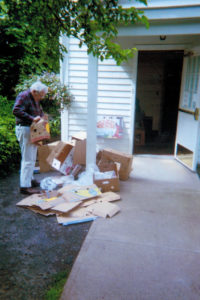
Part 1
I began this memoir before I even knew it. On the first day I worked in the basement food pantry, I sat with Mary, a member of St. Gregory’s Episcopal Church and the head of the alter society. We greeted a couple dozen hungry people. Mostly single homeless men, there were a few of Woodstock’s famous colorful characters included in the mix that day.
Throughout my career in the pantry, the most colorful of the colorful was Grandpa Woodstock who liked to bring his bride, Lady Estar into the pantry to shop. The two of them went around the room choosing from peanut butter, cereal, tuna fish, and soup. While this happened, he entertained us gushing enthusiastically.
“My, how beautiful you look today!” I fell for his spiel every pantry day. Those words melted my heart. The most professional of the street actors, he knew how to make us each feel special when he flashed his peace sign and posed for photographs. Grandpa knew how to flash that peace sign, whip out his postcards to sell, and sound off his horn “toot toot”. I sometimes thought he spent a few afternoons posing in front of a mirror to figure out how to get the best response from tourists.
Grandpa Woodstock and Lady Estar were most photogenic with their long, flowing silver hair. Their lovely matching beards only emphasized floral print silk skirts and kimonos. Their toenails were painted matching colors and their Teva sandals matched.
None of Woodstock’s rich and famous got so many requests for autographs and photographs. They simply couldn’t compete with his show off tricks.
After all, Grandpa entertained us all with street theater at its finest. So what if he didn’t mean a word of it? We all enjoyed being sucked into the show!

 Thank you for reading this article. Please refer it to your preferred social media network.
Thank you for reading this article. Please refer it to your preferred social media network.
Thurman Greco

Hunger: An Introduction
The first time I ever saw a child begging for food was in Mexico. I was on a car trip going through Monterrey on the way to visit my future in-laws in Mexico City. When we parked the car in front of a restaurant, children immediately surrounded the vehicle. Small children held their hands out, asking for money for food. Each held up little brown palms. Their pleading faces looked into my eyes.
At that time, I didn’t yet speak any Spanish, but I didn’t need a vocabulary beyond English to understand the situation. Their body language spoke of expectations, hope and hunger.
“Don’t worry yourself about this Coit. They’re just after a few pesos.” My soon-to-be husband tried to comfort me. In my heart I knew different. The child we discussed was about the size of a thin eight-year-old. Teeth don’t lie though. He had a mouth full of adult teeth. That put his age at about twelve years.
In Mexico, children dig through trash for food. And, nine years after this road trip, in Mexico City, a beautiful young Indian woman standing on a corner tried to sell her infant. She approached my church friends first, an American couple in Mexico City on a study visa. Bob and Sue felt they couldn’t get the baby over the border when they returned to the U.S. at the end of their class. I wasn’t a good candidate because, at the time we discussed the baby, I was still married, had no visa or citizenship papers, and didn’t feel I was ever going to cross back over the river heading North.
Whatever happened to that beautiful baby? Whatever happened to her desperate mother? I’ll never know.
You want to talk hunger, then let’s discuss Venezuela and Mexico for a while. Even now, years later, I remember each encounter with a hungry person or household as if it happened only yesterday. I’ll never forget those people, the look of hunger in their eyes.
When people wanted to talk to me about hunger in America, it was a nonissue. Hunger in America? Whoever heard of such a thing?
Hunger has been with us in this country since the beginning. Famous American history stories include Pilgrims starving over the first winter in their new home. The stories of Mormons starving when they headed west are just two. These stories are different from segments of our population going to bed hungry because there isn’t enough money for food.
Even though I’m the loudest mouth in the crowd when I talk about hungry people in America, I’ve never seen hungry children begging for food when I park my car outside a store or restaurant.
Somehow, in this country, hungry people keep themselves hidden unless they are in the food pantry or soup kitchen line.
I lived in both of those places. I could talk hunger with you “until the cows come home,” as my grandmother said. But America? “Fuggedaboutit,” as I heard someone say once on a Brooklyn bus tour.
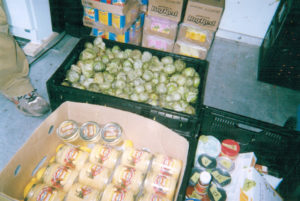
Thank you for reading this blog post. It is an excerpt from “The Ketchup Sandwich Chronicles”. I’ll be posting more stories from this book in the coming days.
I hope you enjoy them. If so, please refer the posts to your favorite social media network.
But, whether you refer them or not, I thank you for reading this story.
Thurman Greco


Are You Working On or Off?

A fairly common question I heard in the pantry line: “Are you working on or off?”
The first time I heard this question, I was confused. What did it mean? Actually, it referred to whether or not the person was paid in cash under the table or was paid money with withholding taken out.
Often the answer was something like: “I’ve got two days over at the food store and three days at Mrs. O……’s where I help her with her house and her office. I’m looking for a few more hours but it’s not happening.”
What this question asked was how many hours a person worked on the books and how many hours off the books. Not only was this practice illegal but it robbed workers of any benefit accrual and the opportunity to pay taxes.
Minimum wage paychecks simply don’t last a week. Individuals, families, entire households even can be employed and still live in poverty. My experience in the pantry was that more people in the pantry shopping line are employed than not.
I used to think of people as being employed or unemployed.
As I gained experience with the situation, I added another label: underemployed. So, rather than thinking in terms of employed or unemployed, I thought of hungry people in the line as being employed or underemployed.
I still see unemployed people but I realized many people aren’t paid a living wage.
I see shoppers where each person in the household works more than one job. The hope, dream, goal for many is simply to work enough hours and make enough money that a person can take a day off occasionally and have enough money to eat the following day.
People holding down more than one job often had trouble finding time to get to the Department of Social Services office to apply for SNAP (food stamps), although they might have qualified for the benefits.
Without a secure community safety net for the poor and destitute in our country, pantry volunteers needed to feed groceries weekly to families and households without money after they paid for rent and transportation to get to work.
Since the ’90s, many states have been “hell bent to Harry” to get people to work…no matter what. Welfare is no longer on the table.
A tip: Some people don’t realize our nation hasn’t offered much in the way of welfare in a long, long time. In polite conversation, I heard a statement: “That person shouldn’t be in your line. Her son has a job and she has a car.” I find it amazing that people in this country have been and continue to be comfortable denying assistance to the needy and destitute families while offering tax breaks to the wealthy.
My question was this: “How do people cope?”
Work first is not always a good option. I regularly saw pantry shoppers with family members who would be institutionalized if they weren’t being cared for by family. The institution is always the more expensive option.
The problem was that the family had nothing. So, while Helen or Sue or Fred was caring for the ill/disabled person, s/he wasn’t able to work.
Employment opportunities are a large part of the problem. People find themselves down and out in places with few job opportunities. Young people graduated from high school or college and can’t find a job anywhere.
Every economic downturn erases job opportunities. When the economy finally recovers, many jobs don’t return. Each recovery creates a class of citizens permanently living in the poverty of unemployment, underemployment, temporary employment, and day labor. Part time employment and being “on call” is a way of life.
The new group created after the downturn of 2008 had its own label: The Struggling Class.
Education costs are a factor. Fewer and fewer people can afford college or trade school. Some are afraid of the college loans they might not be able to pay off. One young woman in our food pantry line worked sixty hours weekly in low wage jobs to repay her college loan.
A fundamental attitude adjustment helped us realize food stamps, food pantries, soup kitchens, and shelters are no longer emergency concepts. They are the new way of life in the 21st century.
BEN
“I’m finished!” he blurted out. ” They fired me today!” I’ll never be able to get another job again. I’m too old!” Frightened reality covered his face when he entered the pantry for the first time. I didn’t say a word. I let him shout. He didn’t look or act as if he was going to hurt anyone and I felt he needed to release his anger.
I wanted his life to be easier than it was but what I wanted for him or any other shopper was nothing more than wishful thinking. There was little to nothing I could do. And, truthfully, I was helpless to do anything for him beyond offering a three-day-supply of food.
Every week after the first visit, he entered the pantry, shopped, and never made a sound. The mask of his face never changed.
Once the hair goes grey, it’s hard to compete in the market place. In a down economy, employers hire the younger applicants believing they’ll work harder for less money.
I hoped his unemployment would hold out until he could figure out how to get something more.
We all just left him alone. The pantry space was so small. It took him a year to calm down.
All we had was delicious, nutritious, food with a heavy emphasis on fresh vegetables and fruits. I relied on the food to make up for what we didn’t have.
I saw him recently – calm, maybe at peace with his situation. He lives in his truck, semi-homeless I suppose. He has places to bathe and sleep when he’s in Woodstock.
Woodstock attracts musicians. He’s one of those considered talented, this man. He’s found places to play around the area and he’s looking okay. What more can we all ask for anyway?
Thurman Greco
Thank you for reading this blog post. Please refer it to your favorite social media network.
Thurman
A new book is coming soon! Please be on the lookout for Miracles!
Thanks again!
Holiday Christmas Feast December 25th at Congregation Emanuel
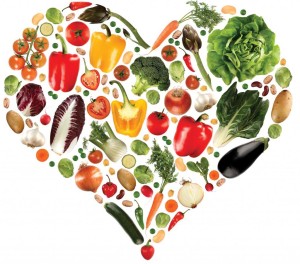
Congregation Emanuel of the Hudson Valley at 243 Albany Avenue, Kingston, NY 12401 is having its second annual Christmas Feast on December 25th from noon until 3:00 pm.
You are invited!
Christmas Feast Holiday dinners are always a good time to get together with others and get to know new people. Holiday dinners are a good time to sit at a table and swap news stories and enjoy food with one another. The members and volunteers at Congregational Emanuel hope you’ll join us at the Feast on the 25th.
Thank you for reading this article. Please share this blog post with your friends and refer it to your preferred social network. Please don’t forget to tell your friends about this feast and share this post with your email neighbors.
Thank you –
Thurman Greco

May the coming new year bring you the best of all you need and desire.
I Don’t Hang Out in Churches Anymore – Coming Soon!
 IT’S COMING SOON!
IT’S COMING SOON!
After countless reams of computer paper, dozens and dozens of writing classes, three computers and two copiers, the book about hunger is at the publisher’s!
And, I actually heard the word “done” today! I’m ecstatic beyond words!
Somebody else could have done it with only one computer disaster and one copier blow up. But, I never claimed to be a writer.
This endeavor took years. And, it was worth it. I felt this story needed to be told when I started writing it in 2013 and I’m sticking to my opinion. Hunger in America was then and is now a national event which needs to be shared.
A real Woodstock story, “I Don’t Hang Out in Churches Anymore” tells about the people in the pantry, channels my grandmother, and reveals a few miracles.
I’m proud to say that “I Don’t Hang Out in Churches Anymore” will, within days, be available in paperback and eBook editions on Amazon.
I am already scheduling book signings for this book. If you are in the area, I look forward to seeing you at one near you!
You can purchase this book by going to my website at http://www.thurmangreco.com.
Order your copy, and please share this unbelievably exciting news!
Thurman

Please share this blog article with your preferred social media network!
Motel 19
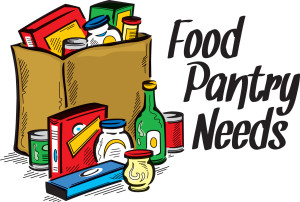
Everyone coming to a pantry travels down a path. For many, this journey is a real load lightener. As the finances erode, the house goes. And, of course, when the house goes, everything that was in it goes too.
Furniture, kitchen stuff, toys, clothes, tools, garden implements. By the time a person or family gets to Motel 19, things have slimmed down to a few clothes, a blanket or two, a hot plate, or maybe an electric skillet or microwave.
For the families living in Model 19, the children are usually eligible for the school breakfast and/or lunch program. But, that doesn’t cover eating at home. And, there’s no lunch program for the adults.
So…it’s off to the pantry.
Several families usually pile in a car and come over for an afternoon of pantry shopping. Or, an individual hitch hikes. In order for this trip to succeed, several guidelines to follow will help:
Try to arrive an hour or so before the pantry opens. This makes for a long wait but there’s more of a selection right when the pantry opens. Also, while waiting in line, there’s an opportunity to make new friends and learn a few survival skills if you’re new to the pantry experience.
Bring your own shopping bags. Some pantries don’t have enough of these much needed items.
Bring some ID. Some pantries require much: picture ID, proof of address, proof that other household members exist. This can be a bit tough if you’re homeless. Hint: some pantries require little to no identification
Be prepared to wait in a line. Use this time to meet your line neighbors. They can be helpful if you’re trying to navigate your way through DSS, if you’re being foreclosed upon, need your car repaired, etc.
As you wait in line, try to learn how the pantry works from those around you in the line. You’ll want to know how long you’ll be in the shopping room, what foods are usually on the shelves, what other pantries the people in line shop at, etc.
Don’t be afraid to let people know you’ve never been to a pantry.
Once you find a pantry you can use, go every time you’re allowed. If you’re lucky, you’ll have a pantry in your area which will allow weekly visits. Because pantry shopping takes so much time, shoppers sometimes just don’t go if they still have SNAP card money or if they have a few bucks left over from a paycheck. Your best bet is to go every week.
Why? Most pantries have different food every week and you may miss out on some real savings by not attending regularly.
Pantry shopping requires a totally new approach to cooking. So does cooking with only an electric skillet or microwave.
Some pantries have periodic visits from a nutritionist. Don’t be shy about asking him/her for any tips you might need to help this adjustment a bit easier for you. Nutritionists know a lot about the food you are now trying to cook with and they can answer any questions you might have.
Thanks for reading this blog post.
Please share this article with your favorite social media network.

PS: This book is at the publisher’s now. It will be available SOON! You can order it at http://www.thurmangreco.com.
Thanks,
Thurman Greco

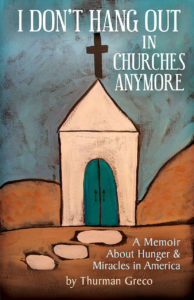
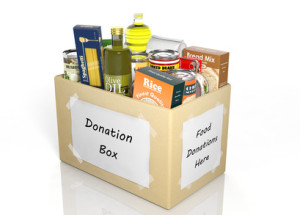 The homeless have problems just like you and me: employment, health issues, disabilities, domestic violence. They just don’t have a roof over their heads.
The homeless have problems just like you and me: employment, health issues, disabilities, domestic violence. They just don’t have a roof over their heads.
